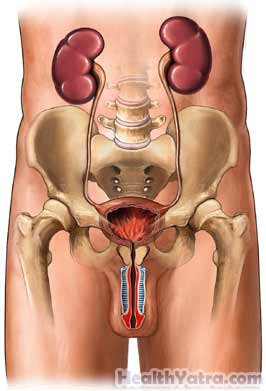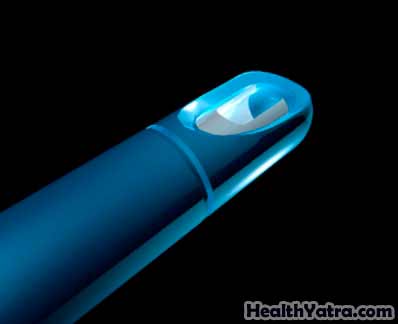সংজ্ঞা
A doctor guides robotic arms to do urologic surgery. This is done through several tiny “keyhole” incisions.

পদ্ধতির কারণ
Examples of urologic surgeries that have been successfully done using this technique include:
- Prostatectomy —to remove part or all of a prostate gland found to contain prostate cancer
- Pyeloplasty —to repair an abnormality of the kidney and nearby ureter (tube that leads from the kidney to the bladder)
- Cystectomy —to remove all or part of the bladder to treat bladder cancer
- Nephrectomy —to remove all or part of the kidney because of kidney cancer, kidney stones, or kidney disease
- Ureteral reimplantation—to disconnect and reinsert the ureter from the bladder to keep urine from flowing backwards from the bladder into the kidneys
- Procedures requiring fine dissection and suturing (eg, reconnection of the ureter)
Compared to more traditional procedures, robotic-assisted surgery may result in:
- Less scarring
- Reduced recovery times
- Less risk of infection
- Less blood loss
- Reduced trauma to the body
- Shorter hospital stay
- Faster recovery
সম্ভাব্য জটিলতা
Complications are rare, but no procedure is completely free of risk. If you are planning to have a robot-assisted urologic procedure, your doctor will review a list of possible complications, which may include:
- Damage to neighboring organs or structures
- সংক্রমণ
- রক্তপাত
- এনেস্থেশিয়া সংক্রান্ত সমস্যা
- The need to switch to traditional surgical methods (eg, traditional laparoscopic or open surgery)
জটিলতার ঝুঁকি বাড়াতে পারে এমন কিছু কারণের মধ্যে রয়েছে:
- প্রাক-বিদ্যমান হার্ট বা ফুসফুসের অবস্থা
- উন্নত বয়স
- ডায়াবেটিস
- স্থূলতা
- ধূমপান
- অতিরিক্ত অ্যালকোহল গ্রহণ
- নির্দিষ্ট ওষুধের ব্যবহার
পদ্ধতির আগে আপনার ডাক্তারের সাথে এই ঝুঁকিগুলি নিয়ে আলোচনা করতে ভুলবেন না।
কি আশা করা যায়
পদ্ধতির আগে
Depending on the reason for your surgery, your doctor may do the following:
- শারীরিক পরীক্ষা
- রক্ত পরীক্ষা এবং প্রস্রাব পরীক্ষা
- Electrocardiogram (ECG, EKG) —a test that records the electrical currents passing through the heart muscle
- Intravenous pyelogram (IVP) —a type of x-ray that creates images of the kidney, ureters and bladder by injecting contrast into the bloodstream
- Retrograde pyelogram—a type of x-ray that creates images of the ureters and kidneys by injecting contrast into the ureter through the bladder
- Kidneys, ureter, bladder (KUB) —an x-ray of the abdomen
- Ultrasound —a test that uses sound waves to visualize the inside of the body
- CT scan —a type of x-ray that uses a computer to create images of structures inside the body
- MRI scan —a test that uses powerful magnets and radiowaves to create images of structures inside the body
- Cystoscopy —a lighted tube equipped with a camera used to visualize the inside of the urethra and bladder
পদ্ধতি পর্যন্ত নেতৃত্ব:
- আপনার ওষুধ সম্পর্কে আপনার ডাক্তারের সাথে কথা বলুন। পদ্ধতির এক সপ্তাহ আগে আপনাকে কিছু ওষুধ খাওয়া বন্ধ করতে বলা হতে পারে, যেমন:
- প্রদাহ বিরোধী ওষুধ (যেমন, অ্যাসপিরিন)
- Blood thinners such as clopidogrel (Plavix) or warfarin (Coumadin)
- Take antibiotics if instructed.
- Follow a special diet if instructed.
- Shower the night before using antibacterial soap if instructed.
- Arrange for someone to drive you home from the hospital. Also, have someone to help you at home.
- আগের রাতে হালকা খাবার খান। খাওয়া বা মধ্যরাত্রি পরে কিছু পান করবেন না।
এনেস্থেশিয়া
General anesthesia will be used. It will block any pain and keep you asleep through the surgery.
পদ্ধতির বর্ণনা
Several small keyhole incisions will be made in the abdomen. Carbon dioxide gas will be passed into the area. This will make it easier for the doctor to see the internal structures. The doctor will then pass a small camera, called an endoscope, through one of the incisions. The camera will light, magnify, and project the structures onto a video screen. The camera will be attached to one of the robotic arms. The other arms will hold instruments for grasping, cutting, dissecting, and suturing; for example:
- Forceps
- Scissors
- Dissectors
- Scalpels

While sitting at a console near the operating table, the doctor will look through lenses at a magnified 3D image of the inside of the body. Another doctor will stay by the table to adjust the camera and tools. With joystick-like controls and foot pedals, the doctor will do the surgery by guiding the robotic arms and tools. After the tools are removed, the doctor will use sutures or staples to close the surgical area.
কতক্ষণ এটা লাগবে?
About 2-4 hours (depending on the procedure)
এটা আঘাত করবে?
You will have pain and discomfort during recovery. Your doctor will give you pain medicine. You may also feel bloated or have pain in your shoulder from the gas used during the procedure. This can last up to three days.
গড় হাসপাতালে থাকার
About 1-2 days (depending on the procedure)
পোস্ট-প্রক্রিয়া যত্ন
আপনি যখন বাড়িতে ফিরে আসবেন, একটি মসৃণ পুনরুদ্ধার নিশ্চিত করতে নিম্নলিখিতগুলি করুন:
- For some procedures, a urine catheter will be left in place for a while. You will be instructed on how to care for this.
- If advised by your doctor, take antibiotics. You will need to avoid other medicines. Talk to your doctor about which ones.
- While resting, keep your legs elevated. Move your legs to avoid blood clots.
- Avoid taking a bath during the first two weeks after surgery.
- Wash the incisions with mild soap and water.
- কখন গোসল করা, গোসল করা বা জলে ভিজানো নিরাপদ সে সম্পর্কে আপনার ডাক্তারকে জিজ্ঞাসা করুন।
- Drink plenty of fluids. This will help to clear your bladder.
- Avoid constipation. Eat a high- fiber diet. Drink plenty of water. Use stool softeners if necessary.
- Avoid caffeinated beverages, alcohol, spicy foods, or other food or drink that might upset your stomach, intestines, or urinary tract.
- Resume normal activities (eg, daily walks) soon. This will promote healing.
- Limit certain activities (eg, driving, working, doing strenuous exercise) until you have recovered.
- আপনার ডাক্তারের নির্দেশাবলী অনুসরণ করতে ভুলবেন না।
Total recovery usually takes about 3-6 weeks.
আপনার ডাক্তারকে কল করুন
আপনি হাসপাতাল ছেড়ে যাওয়ার পরে, নিম্নলিখিতগুলির মধ্যে যেকোনটি ঘটলে আপনার ডাক্তারের সাথে যোগাযোগ করুন:
- Catheter stops draining or falls out (if you had a catheter placed)
- Difficulty urinating
- Heavy bleeding or clots in the urine
- Pain, burning, urgency, or increased frequency of urination
- জ্বর এবং ঠাণ্ডা সহ সংক্রমণের লক্ষণ
- Redness, swelling, increasing pain, excessive bleeding, or discharge from an incision site
- Abdominal swelling or pain
- Constipation, nausea, vomiting, or diarrhea
- কাশি, শ্বাসকষ্ট বা বুকে ব্যথা
- আপনার পা, বাছুর বা পায়ে ব্যথা এবং/অথবা ফোলা
- Other worrisome symptoms
জরুরী পরিস্থিতিতে, অবিলম্বে চিকিৎসা সহায়তার জন্য কল করুন।
